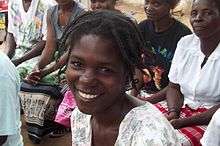Women in Angola
Although almost no research existed on the role of women in Angolan society in the late 1980s, there are a few generalities that could be drawn. In rural Angola, as in many African economies, most of the population engaged in agricultural activities. Women performed much of the agricultural labor. Marriage generally involved familial, political, and economic interests as well as personal considerations and gains. The household was the most important unit of production and was usually composed of several generations. The women grew and prepared most of the food for the household and performed all other domestic work. Because of their major role in food production, women shared relatively equal status with men, who spent much of their time hunting or tending cattle.
 Angolan woman participating in an adult literacy program | |
| Global Gender Gap Index[1] | |
|---|---|
| Value | 0.633 (2018) |
| Rank | 125th out of 149 |
It has been calculated that almost 25 million adults and children were living with HIV in sub-Saharan Africa at the end of 2005. During 2005, an estimated two million AIDS-related deaths occurred in Africa, leaving behind some twelve million orphans.[2] A study of nearly 2000 individuals in 2005 shows that intervention programs that promote condom use are very effective in reducing this number, by addressing common myths surrounding birth control.[3] Separate studies have shown that HIV positive pregnant women have much worse mental health than those who don't and that two-thirds of this same group had severe mental distress.[4]
Angola has a high breast cancer mortality rate, which has been attributed to a lack of symptom awareness that leads to a late diagnosis.[5] In a survey of 595 students in university, around 65% were not aware that breast cancer was one of the deadliest cancers in Sub-Saharan Africa, and less than 35% knew that it could also affect men. Progress is being made to use universities as well as popular social media networks (Facebook, Twitter) to further teach students about awareness and self-examinations, which students also admitted that they were not familiar with.[5][6]
Many women belonged to the Organization of Angolan Women (Organização da Mulher Angolana—OMA). Before independence, the OMA was instrumental in mobilizing political support for the MPLA among thousands of Angolan refugees. After independence, and especially after the creation of the MPLA-PT in 1977, the mass organizations came under the strict control of the party and were given the role of intermediaries between the MPLA-PT and the population. Women's participation in the government has not increased at the rate that participation in other countries with similar political environments have, but women-friendly policies have still been enacted since the 1980s. As stated in the Quota Project of 2012, the National Assembly (Angola) consisted of 35% women, and the number of female justices in Constitutional Court of Angola was 4 out of 11.[7] Angolan media is also to blame for the gender-stereotyped roles present in current day Angola. One example of this can be found the highly publicized Miss Angola program, endorsed by many provinces of Angola who spend large sums of money promoting the event.[8]
Another program of which the Angolan government created in order to elevate women's status is the Ministry for Family and Women, a group that helped separate women's issues from the political agenda. However, even with new programs like these, little progress has been made to institutionalize proper programs to reform issues such as voting rates and pregnancy awareness. The Ministry for Family and Women continues to be one of the most underfunded programs in Angola, giving it little room to expand or produce tangible results.[9]
In 1987, the OMA had a membership of 1.3 million women, most of whom lived in rural areas. Among the many contributions of OMA's members were the establishment of literacy programs and service in health and social service organizations. Most OMA members, however, were poor and unemployed. In 1988 only 10 percent of MPLA-PT members were women, although more women found jobs in teaching and professions where they had been excluded in the past.
References
![]()
- "The Global Gender Gap Report 2018" (PDF). World Economic Forum. pp. 10–11.
- Joint United Nations Programme on HIV/AIDS (UNAIDS) ( 2004 ). Report on the global AIDS epidemic . : UNAIDS .
- Prata, Ndola, et al. “Gender and Relationship Differences in Condom Use among 15-24-Year-Olds in Angola.” International Family Planning Perspectives, vol. 31, no. 4, 2005, pp. 192–199. JSTOR, JSTOR, www.jstor.org/stable/3649535.
- Mona R. Loutfy, Ulrike Sonnenberg-Schwan, Shari Margolese, Lorraine Sherr, on behalf of Women for Positive Action. (2013) A review of reproductive health research, guidelines and related gaps for women living with HIV. AIDS Care 25:6, pages 657-666.
- Sambanje, M N, and B Mafuvadze. “Breast cancer knowledge and awareness among university students in Angola.” Pan African Medical Journal, 64 Apr. 2012. African Journals Online.
- Oladimeji, Kelechi Elizabeth; Tsoka-Gwegweni, Joyce M.; Igbodekwe, Franklin C.; Twomey, Mary; Akolo, Christopher; Balarabe, Hadiza Sabuwa; Atilola, Olayinka; Jegede, Oluwole; Oladimeji, Olanrewaju (25 November 2015). "Knowledge and Beliefs of Breast Self-Examination and Breast Cancer among Market Women in Ibadan, South West, Nigeria". PLOS ONE. 10 (11): e0140904. doi:10.1371/journal.pone.0140904. PMC 4659560. PMID 26606137.
- Tripp, Aili Mari. Women and Power in Post-Conflict Africa. Cambridge University, 2015.
- Ducados, Henda. "Angolan women in the aftermath of conflict." From Military Peace to Social Justice? The Angolan Peace Process (2004).
- Ducados, Henda. "Angolan women in the aftermath of conflict." From Military Peace to Social Justice? The Angolan Peace Process (2004).
